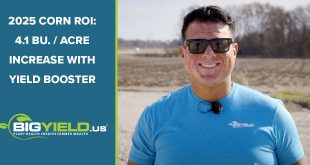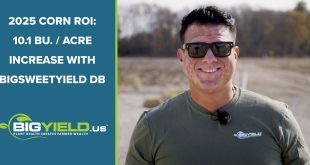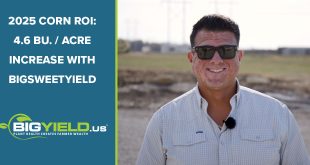Tony Reinsch discusses what he likes to see in a corn fertility program.
Video Transcript
Q: What do you recommend for corn fertility?
With corn fertility, I am a huge proponent for in-furrow starter fertilizers. Quality in-furrow starter fertilizers. The reason for that is you get your 100% ortho products.
When the soil temperatures are cold, that product is still available to that plant. Then you see some of your 80% or 60% ortho products. You have poly and you have ortho. The poly is not available to that plant until the soil temperature is sitting around – you talk to every university they are going to have a different saying – usually around 65 degrees. Most soils in Nebraska don’t get up to 65 degrees until Memorial Day weekend or after. Most of the corn in Nebraska is getting planted probably around the middle of April. So there is a month and a half that corn seed is laying there growing – once it is germinated – it’s growing without any nutrients. It’s just pulling what it can from the soil.
The reason the in-furrow products are so important is you are placing that either right under the seed or right on top of the seed so that the nutrients are right there. Or you are placing that in a 2×2 placement. When that radical starts growing it’s going to hit that band of fertilizer right away.
You want a good quality starter because with a bad quality starter you’re going to pay a lot of money for heavy metals. And a plant cannot uptake heavy metals. One analogy I used to use years ago was the little plant is just like a little baby. You don’t feed a baby steak, you feed it baby food. A plant is the same way for the simple fact that those little plants cannot digest that product coming in. They need a high ortho product. They can digest the ortho right away. The can’t digest the poly because a poly chain is really long. A young plant cannot digest that. So it takes a long time for that to break down in the soil.
Now with that being said, I love a good plan. I want to see farmers use fertility wisely to enhance their soil profile. We are taking out extremely good yields. 250 to 300-bushel corn. Sit down and go to the internet sometime and look at the charts of what a 250-bushel corn actually takes out of soil. It takes a huge amount of phosphorus, potassium, sulfur, nitrogen, and all of the micronutrients. I want to make sure that when they are pulling those yields out that they are replacing them the following year – if they are going to go corn after corn the next year – make sure they are replacing them and make sure they are adding more back in there to build that soil profile.
If your soil profile starts to go down because you keep taking too many nutrients out each year your yield is going to end up falling. In Nebraska, most of the farmers – not all of them – most of the farmers are on a rotation. They’re going corn then soybeans. In Eastern Nebraska, we don’t do a lot of wheat. In Western Nebraska, we have a lot of wheat. Right now with the soils up there, most people are building their soil profile.
They are spoon feeding their soils. I’m a big proponent of spoon feeding. I like to see the starter fertilizer. I like to see another nitrogen source out there. I like to see a foliar feeding program. In central Nebraska, we have the privilege of having a lot of center-pivot irrigation. You’ll see a lot of nutrients go through the pivot. That’s good. In places where they don’t have the center-pivot irrigation and they just have gravity or no irrigation at all, they will have to go out there and have an applicator apply it.
But I am a big proponent of spoon feeding crops. Corn, soybeans, wheat, milo, etc. Anytime you can spoon feed a plant it is so much better because as a human being we can only drink so much water. If you gave me 5 gallons of water and that was my allotment for the week and told me to drink it in one day, I couldn’t do it. A plant is the same way. When you are trying to force feed that plant all those nutrients at one time, the plant is unable to metabolize everything. That is why I am a huge proponent of spoon feeding.
Q: What are your thoughts on BP In-Furrow for a corn in-furrow treatment?
BP In-Furrow, from what I have seen, you have your high-quality starter fertilizer, your 3-18-18 in there. You have the microbials – the biologicals – in there. You have the BigSweetYield sweetener in there. When you put those three together what I like about that is you are getting the jump-start from the ortho starter. The microbes are helping that plant because anytime you can create a zone around that seed you are creating a perfect zone – basically, a little nursery if you will for that little seedling. Once that plant starts to germinate, it is going to hit the starter, the microbes, and the sweetener. That sweetener is just going to give that an extra boost.
I correlate that sweetener to a sugar rush in me. I cannot eat a lot of sugar because my body cannot metabolize sugar properly. I’ll go on a sugar high, then I’ll all of a sudden be low. But with the BigSweetYield that is in the BP In-Furrow, that maintains a steady feeding of that plant. It doesn’t give it a lot of sugar – it gives it enough to energize it. And whenever you have a plant that is energized that plant is going to be healthier, it is going to grow faster, and it is going to be kicking butt out there in the field. That’s what really impresses me about the BP In-Furrow.
 BigYield High Yield Soybeans, High Yield Corn, and High Yield Wheat
BigYield High Yield Soybeans, High Yield Corn, and High Yield Wheat



